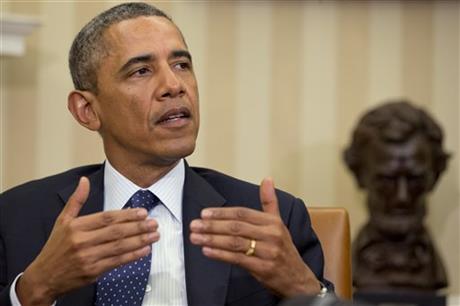
By JIM KUHNHENN
President Barack Obama speaks during a meeting with Spanish Prime Minister Mariano Rajoy in the Oval Office of the White House in Washington, Monday, Jan. 13, 2014. (AP Photo/Jacquelyn Martin)
WASHINGTON (AP) — Ready to put an economic spotlight on his State of the Union address, President Barack Obama is picking up the pace of his jobs message and making a case that, even against a divided Congress, he can still be relevant to people struggling in the up-and-down recovery.
With two weeks left before his message to a joint session of Congress, Obama is showcasing how he can advance his economic agenda administratively and through his ability to coax action from important interest groups.
On Tuesday, Obama is meeting with his Cabinet to discuss measures that can help the middle class. On Wednesday he will go to North Carolina to draw attention to industry steps to increase high-tech manufacturing. On Thursday he has invited college presidents to discuss ways to improve workers’ skills. Later this month, he is convening CEOs at the White House to lay out plans for hiring the long-term unemployed.
“The president will use every tool he can to create new jobs and opportunities for the middle class,” White House senior adviser Dan Pfeiffer writes in an email to be sent Tuesday morning to the White House list of supporters. “He will be looking for areas of bipartisan cooperation, but he won’t be waiting on Congress to act.”
The approach has strong echoes of Obama’s 2012 “We can’t wait” campaign that sought to depict Obama as an impatient executive in the face of inaction from Congress, particularly the Republican-controlled House.
Obama’s reliance on his executive powers and his bully pulpit — at the White House it’s called his “pen-and-phone” strategy — illustrates the means at his disposal but also highlights the limits of his ability to work with Congress.
Only through legislation can Obama obtain some of the most ambitious items on his economic agenda — from a higher minimum wage to universal preschool to an overhaul of immigration laws, three items in his 2013 State of the Union that will make a return appearance in this year’s address.
That means that as long as Republicans in Congress are unreceptive to his legislative priorities, he will have to settle for more incremental and narrower solutions that don’t necessarily have the staying power and the force of law.
Last week, Obama announced that five communities had been designated as “promise zones,” fulfilling a goal he set out in his 2013 State of the Union speech. Last year, Obama also announced that he intended to launch three manufacturing hubs where businesses would work to create centers of high-tech jobs by working in partnership with the Energy and Defense departments. But in an example of his limitations, he also called on Congress to create 15 more similar hubs, a request that went unanswered.
Obama’s determination to use the power of executive orders and administrative actions as well as his decision to convene key figures from private enterprise, education and other interest groups to help advance his agenda also underscore some of the built-in powers of the presidency. Clinton-era White House chief of staff John Podesta, who is joining the White House as a senior adviser, has long pressed Obama to use his executive authority to get around congressional opposition.
Podesta co-authored a report in 2010 for the liberal Center for American Progress that was essentially a treatise on presidential authority. It argued that both presidents George W. Bush and Bill Clinton had enacted aspects of their agendas even in the face of a divided Congress.
“The upshot: Congressional gridlock does not mean the federal government stands still,” Podesta wrote. “This administration has a similar opportunity to use available executive authorities while also working with Congress where possible.”



